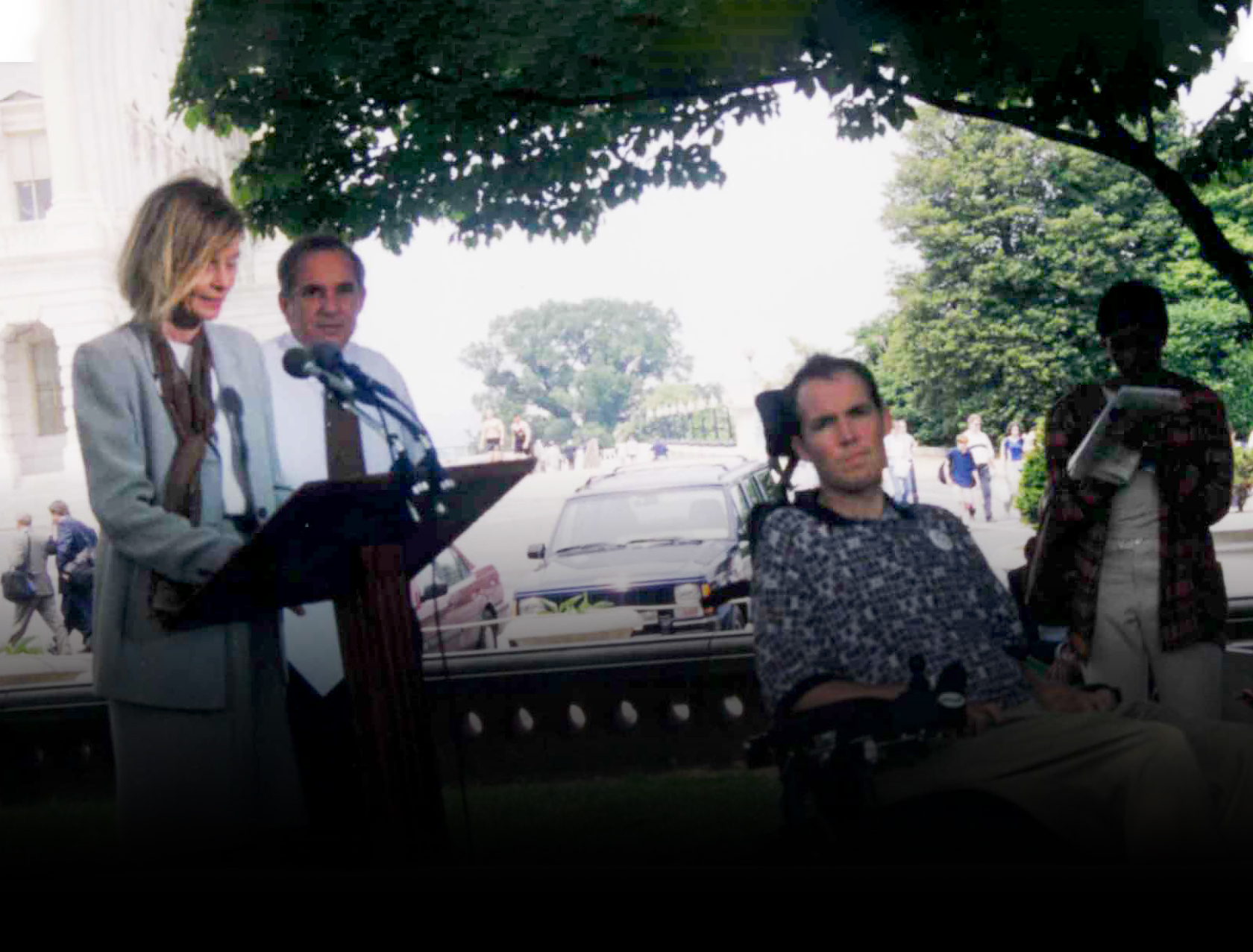In the beginning, his ALS symptoms were easy to ignore: mild stiffness after a game of touch football, difficulty getting up after a fall on the slopes and problems climbing stairs.
My 30-year-old brother, Kevin O’Donnell, initially blamed “old age” and shrugged it off. Soon, lifting his toddler daughter, tying his shoes and driving his car became real challenges. He and his wife Jodi began making the rounds of doctors, orthopedists and specialists. The doctors ruled out a brain tumor, spinal problems and autoimmune diseases.
At one point Kevin said, “They all know something and no one wants to tell me what is wrong.”
After seven months of poking and prodding, the neurology department at Hahnemann Hospital in Philadelphia asked Kevin to come in with his family. We gathered beforehand at a local monastery, held hands and prayed.
At the hospital, Kevin received the final, definitive test: electromyography (EMG), which delivered small electric shocks through the nerves of his legs, hands and tongue. The doctor measured how fast these areas conducted electricity to determine whether they were damaged.
At the end of a long day, we heard the diagnosis we were dreading: Amyotrophic lateral sclerosis, more commonly known as ALS. While Kevin was relieved to have a diagnosis, reality quickly set in. There is no known cure or treatment for ALS. His life expectancy would be two to five years.
According to the ALS Association, amyotrophic lateral sclerosis is a progressive neurodegenerative disease that affects nerve cells in the brain and the spinal cord. Motor neurons connect the brain to the spinal cord and the spinal cord to the muscles throughout the body. The progressive degeneration of the motor neurons in ALS eventually leads to their death. When motor neurons die, the ability of the brain to initiate and control muscle movement is lost. With voluntary muscle action progressively affected, the individual loses the ability to speak, eat, move and breathe. The motor nerves that are affected by ALS are the neurons that provide voluntary movements and muscle control.
There are two types of ALS, sporadic and familial1. Sporadic, which is the most common form of the disease in the U.S., accounts for 90-95% of all cases. It may affect anyone, anywhere, and this is the form that afflicted Kevin. Familial ALS (FALS) accounts for 5-10% of all cases in the nation. FALS means the disease is inherited. In those families, there is a 50% chance each offspring will inherit the gene mutation and develop the disease. ALS is age-related; most people find out they have it when they are between 55 and 75 years of age.2
ALS Symptoms
The onset of amyotrophic lateral sclerosis can be subtle, but gradually the symptoms develop into more obvious weakness3. Some early symptoms include:
- Involuntary muscle twitches in the arm, leg, shoulder or tongue (also called fasciculations)
- Muscle cramps
- Tight, stiff muscles (spasticity)
- Muscle weakness affecting an arm, a leg, neck or diaphragm
- Slurred and nasal speech
- Difficulty chewing or swallowing
The Path of ALS
Once ALS starts, it almost always progresses, eventually taking away the ability to walk, dress, write, speak, swallow, and breathe, and shortening the life span. How fast and in what order this occurs is very different from person to person4. While the average survival time is three years, about 20% of people with ALS live five years, 10% will survive 10 years and 5% will live 20 years or more.5
Based on U.S. population studies, more than 5,000 people in the U.S. are diagnosed with ALS each year. (That’s 15 new cases a day). An estimated 16,000 Americans have the disease at any given time. According to the ALS CARE Database:
- 60% of people with ALS are men.
- 93% of people with the disease are Caucasian.
- Military veterans, particularly those deployed during the Gulf War, are approximately twice as likely to develop ALS.
Kevin’s ALS Reality
Within a year of his diagnosis, Kevin began exhibiting more of the effects of lumbar ALS. He progressed rapidly from a cane to a walker, and then a power wheelchair and a handicapped-accessible van. A feeding tube was necessary when choking became a threat. When he could no longer transfer from the wheelchair, a patient lift helped him in and out of bed.
Our family held several fundraisers to convert Kevin and Jodi’s home to handicapped accessible and to help with the other ALS-related expenses. According to alsfoundation.org, care for a patient can cost $200,000 or more per year.
|
|
|
Kevin, the ALS Activist
Throughout my brother’s journey, he never lost sight of how he could improve the lives of others diagnosed with this horrific disease. He was active in a local ALS support group, selected to speak to the new members of the Philadelphia Phillies before their annual ALS fundraising mission, and petitioned the FDA to bypass the lengthy testing process for experimental ALS medications.
Kevin also met with then-Senator Robert Torricelli and became the driving force behind The ALS Treatment and Assistance Act. Most ALS patients don’t live long enough beyond the two-year waiting period to receive Medicare benefits. The ALS Treatment and Assistance Act removed this regulation. The Act was revised to eliminate the five-month waiting period for Social Security Disability Insurance.
Kevin’s Final Journey
When Kevin could no longer breathe on his own he made the decision to go on a ventilator. This would require skilled, round-the-clock nursing care. He became unable to speak and we learned to read his lips. Kevin’s wife Jodi and my mom quit their jobs to take care of him during the day. My dad, who was retired, also assisted in Kevin’s care.
Family and friends were enlisted for everything from cooking and cleaning to physical therapy and personal care. Kevin’s mind remained clear and unaffected, and he continued his profession as a commercial loan analyst for Commerce Bank for the majority of his illness.
Six years after his diagnosis, Kevin made the decision to be removed from the ventilator and he passed away within hours. He was 36 years old.
1National Institutes of Health, “Health Conditions: Amyotrophic Lateral Sclerosis”
2Centers for Disease Control and Prevention, “Amyotrophic lateral sclerosis (ALS)”
3National Institutes of Health, “ALS Fact Sheet”
4ALS News Today, “Stages of ALS”
5ALS Association, “Who Gets ALS?”
More Resources:
Video: Meet Kevin O’Donnell
Hope Loves Company (HLC): Kevin’s wife formed HLC, the only non-profit in the U.S. that provides educational and emotional support for children with a parent or loved one battling ALS.
ALS Association, “New Scholarship Program for Students Affected by ALS”
BioSpace, “ALS Patients Wait for Potential Cure”
Centers for Disease Control and Prevention, “The ALS Registry: Hope for Patients, Resources for Research”
Mayo Clinic, “ALS Medications, ALS Therapies”











